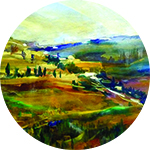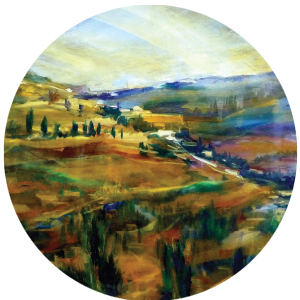For the Love of G-d

In the turmoil of exile, discomfort spurs us to turn to Him
As we
Winter has the longest nights — we don’t just fall asleep in darkness, we wake up and face darkness again. Life feels like that right now; the pandemic hitting ever stronger, rattling us to the core.
Someone from my kehillah, a woman with much self-awareness, asked what many may be wondering: “Rebbetzin, what is this and when will it end? How can I grow through this?”
My answer was lengthy, but opened with one word: galus.
It’s Been a Long Time
In the post-Holocaust era, the Torah world has been built up with such magnificence, it’s almost an open miracle. While the resettlement of our homeland has been turbulent, Eretz Yisrael’s outstanding success as a makom Torah and an international leader in innovation and technology is also l’maalah min hateva.
The last half a century has also heralded materialistic explosion, rising influence of Jews in government in the Diaspora, and a general sense of confidence and safety among the general Jewish population.
Galus, explains the Maharal, is a feeling of insecurity, or quite literally —displacement. That feeling has been diluted in our era.
The Navi Yeshayah (60:21) promises that our nation will be a “netzer mata’i.” The Malbim explains this to mean, “the fledgling sapling I planted.” Hashem will care for us as though we’re a seedling He planted, and the flowering plant we become will glorify His Name.
We know that uprooting plants can cause severe damage if the roots are left exposed to the air for an extended period of time. We’ve been in galus so many years. It’s been so long since we’ve felt Hashem nurturing us like a gardener. Do we even remember how to glorify His Name?
It’s that sense of not belonging, of being different, that heightens our awareness of our nation’s royal identity, that we’re the am hanivchar. And then, the opportunities for kiddush Hashem become infinite.
Thriving from Challenge
Both the Malbim and later Rav Shlomo Wolbe discuss the oxymoronic reality of how being shaken up strengthens the Jewish People.
In Mishlei, Shlomo Hamelech says (10:27), “Yiras Hashem tosif yamim, fear of Hashem lengthens our days.” The Malbim comments: “Though fear is something that usually shortens days, this is not so with the fear of Hashem.”
He further stymies us by adding that one who has fear of Hashem will have days of “goodness and tranquility.” Yet the Malbim himself experienced much personal suffering as a result of his staunch yiras Shamayim. In 1860, he was appointed chief rabbi of Bucharest, Romania. There, he clashed with German Jewish leaders who wished to introduce Reform practices to the community. As a result, the Malbim was unfairly imprisoned.
Though Sir Moses Montefiore was able to secure his release, he was expelled from Romania. He then moved from rabbinic post to rabbinic post throughout the Russian Empire, each time clashing with German Jews trying to spread the ideas of the Haskalah, and being forced to leave. He fell sick and died in Kiev while en route to a new post.
Despite his fear of Hashem, his life seems to be far from the description of good and tranquil.
Can we emulate the Malbim, and truly achieve tranquility despite experiencing turbulent times? How can we see difficulty as “good”?
Rav Wolbe, in Alei Shur (1) points to one of the opening pesukim in Torah (Bereishis 1:6), “And Hashem said, ‘Let there be a sky in the midst of the water, and it will separate between water and water.’ ”
Rashi explains that though the heavens had been already created on Day One of Creation, they remained soft and moist. The act of creation on Day Two was: “Let the sky harden” (in archaic English the sky is called the firmament.)
Rashi explains that HaKadosh Baruch Hu’s command, “Let there be sky” was so startling to the heavens that it immediately seized and became solid, “like one who freezes from shock when he is rebuked by someone he finds threatening.” The message of this Rashi is: Discomfort can makes us strong, and firm.
Queries Rav Wolbe: But how? He says, “My beloved reader, you see these things and wonder… how does the one who is shaking achieve stability specifically from this state? And I cannot explain this. Whatever is said about yiras Hashem is not enough to reach the heart of one who hears or reads about it… One must arrive personally at distinct moments of true yirah — then he will know and feel for himself.”
Far be it from me to think I can explain something that Rav Wolbe ztz”l said he couldn’t. Yet I can testify, as one whose life has been a roller coaster of experiences, some very challenging, that there’s something to this phenomena.
When something drastic, unexpected, and jolting occurs, I realize that no one other than the Ribbono shel Olam could possibly make this happen to me. That reality propels me to reach out to Him and know that He’s the only zokef kefufim who can keep me standing when bent over in pain.
The suffering I’m experiencing is a command to get strong: strong in my emunah, strong in my ability to not only stand tall, but smile — and sometimes even laugh.
Lovesick
For thousands of years, the glitter of the smokescreen that surrounds us has drawn so many away from fidelity to our People and our mesorah. The suffering we’ve experienced has caused many hearts to loosen their connection to our Creator.
Yet among the wan, some remain steadfast. The “crazies,” those of us who refuse to allow our faith to disappear, are sick with love for Hashem; cholas ahavah ani (Shir Hashirim 2:5).
And yes — ahavah mekalkeles es hashurah, love distorts what makes sense (Midrash Rabbah Vayeira). Like our forefather Avraham, who ran to saddle the donkey on the morning he was going to sacrifice his son, sometimes it makes no sense. But as Rav Wolbe told us, when you experience it, you’ll feel that it’s true.
Rising from the Rut
Avraham chose galus for us when Hashem asked him what he preferred for his children: galus or Gehinnom. Midrash Rabbah Bereishis (44:24) tells us that Avraham’s intention was that instead of dissolving our sins after our departure from This World, we’d rise from the mire during our lifetimes.
But it’s only when we acknowledge our estrangement from Hashem that we become privy to who we really are. The wishy-washy reality of galus can ensconce us in complacency and drive us away from our true reality.
Rav Wolbe quotes a verse from a 12th-century Erev Rosh Hashanah Selichos called “Dalfah Nafshi,” written by Rabi Yoel bar Yitzchak HaLevi. I will loosely translate it to preserve the beauty of the rhyme:
He serves two masters in accordance to his years as they fill,
Does for Yotzer (Creator) and his Yetzer (Evil Inclination) what they will.
So good is the one who at all times to his Creator he clings,
And from his other “master” his freedom sings.
We can sing! We can find good and tranquility if we detach from the pestering of the yetzer hara. It’s that yetzer that pushes us to worry, to want to give up.
Yes, life shakes us up. But it’s my realization that HaKadosh Baruch Hu is running the show that allows me to stand proud. Perhaps I can even turn on some music and dance. I can breathe and I can create, innovate, and celebrate. I can honor each Shabbos with glory.
When I cling to HaKadosh Baruch Hu, then I become a queen.
Be the queen of your choices. Happiness is a choice, even during these very dark days. When you look outside, you’ll still find the sunshine. The phone is still ringing with besoros tovos.
Let’s keep sharing them!
Rebbetzin Aviva Feiner is the rebbetzin of Far Rockaway’s Congregation Kneseth Israel (The White Shul) as well as a mechaneches in TAG and a visiting lecturer at Stern College.
(Originally featured in Family First, Issue 728)
Oops! We could not locate your form.







